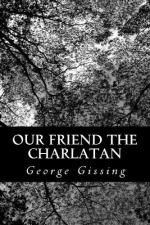“Good morning!” sounded cheerfully from her, as she drew near. “Have you seen the mill?—Come up to the house as soon as you like.”
She had swept past, leaving in Dyce a sense of having been cavalierly treated.
He turned, and followed towards Rivenoak. When he reached the house, Constance was walking among the flower-beds, in her hand a newspaper.
“Do you cycle?” she asked.
“No. I never felt tempted.”
“Lady Ogram is having her drive. Shall we stay in the garden, as the sun is so bright?”
They strolled hither and thither. Constance had a glow in her checks, and spoke with agreeable animation. For a few minutes they talked of the mill, and Dyce repeated the manager’s remark about Miss Bride’s influence; he saw that it pleased her, but she affected to put it carelessly aside.
“How long have you known Lady Ogram?” he inquired.
“A good many years. My father was once a friend of hers—long ago, when he was a curate at Hollingford.”
The circumstances of that friendship, and how it came to an end, were but vaguely known to Constance. She remembered that, when she was still a child, her mother often took her to Rivenoak, where she enjoyed herself in the gardens or the park, and received presents from Lady Ogram, the return journey being often made in their hostess’s carriage. In those days the baronet’s wife was a vigorous adherent of the Church of England, wherein she saw the hope of the country and of mankind. But her orthodoxy discriminated; ever combative, she threw herself into the religious polemics of the time, and not only came to be on very ill terms with her own parish clergyman, but fell foul of the bishop of the diocese, who seemed to her to treat with insufficient consideration certain letters she addressed to him. Then it was that, happening to hear a sermon by the Rev. Mr. Bride in an unfashionable church at Hollingford, she found in it a forcible expression of her own views, and straight way selected Mr. Bride from all the Hollingford clergy as the sole representative of Anglicanism. She spoke of him as “the coming man,” prophesied for him a brilliant career, and began to exert herself on his behalf. Doubtless she would have obtained substantial promotion for the curate of St. John’s, had not her own vehemence and Mr. Bride’s difficult character brought about a painful misunderstanding between them. The curate was not what is known as a gentleman by birth; he had the misfortune to count among his near kinsfolk not only very poor, but decidedly ungenteel, persons. His only sister had married an uneducated man, who, being converted to some nondescript religion, went preaching about the country, and unluckily, in the course of his apostolate, appeared at Hollingford. Here he had some success; crowds attended his open-air sermons. It soon became known that the preacher’s wife, who was always at his side, was a sister of Mr. Bride of St.




